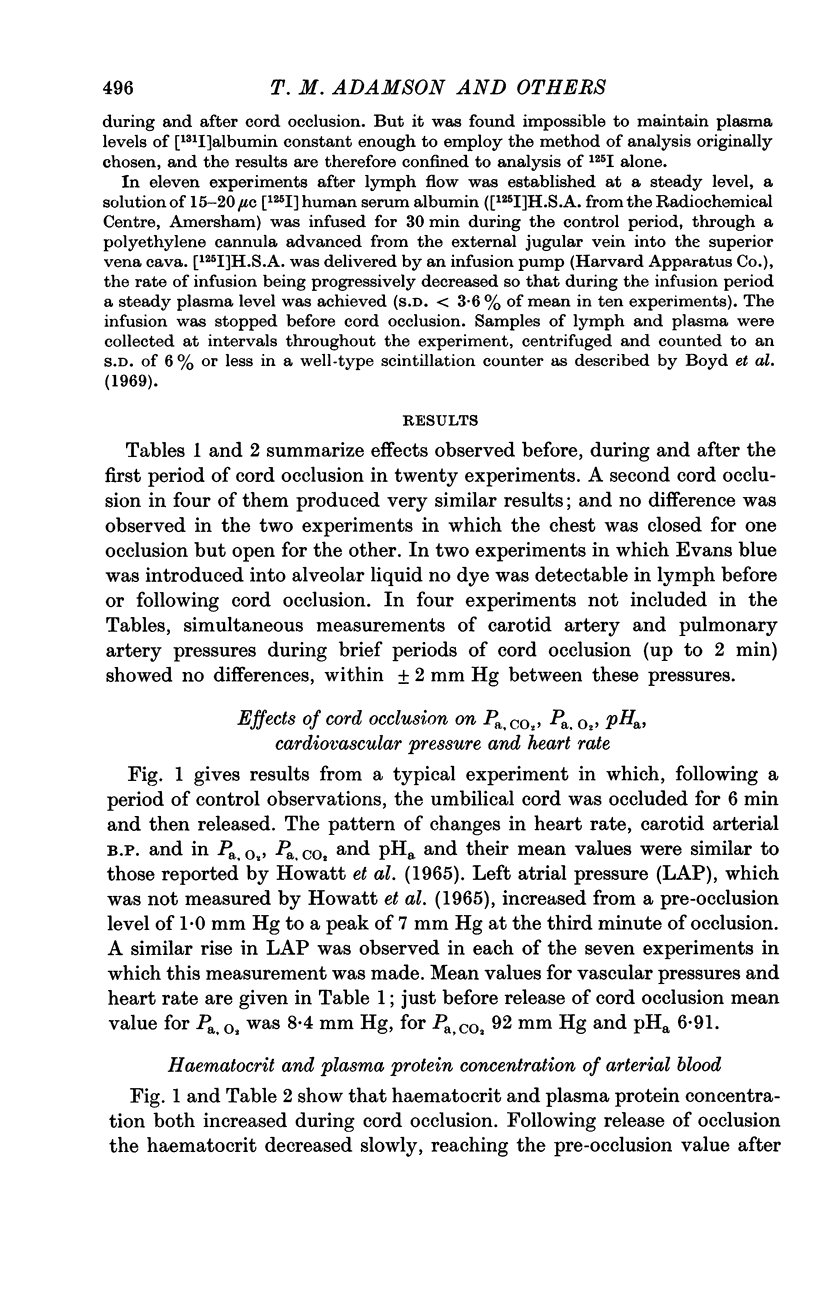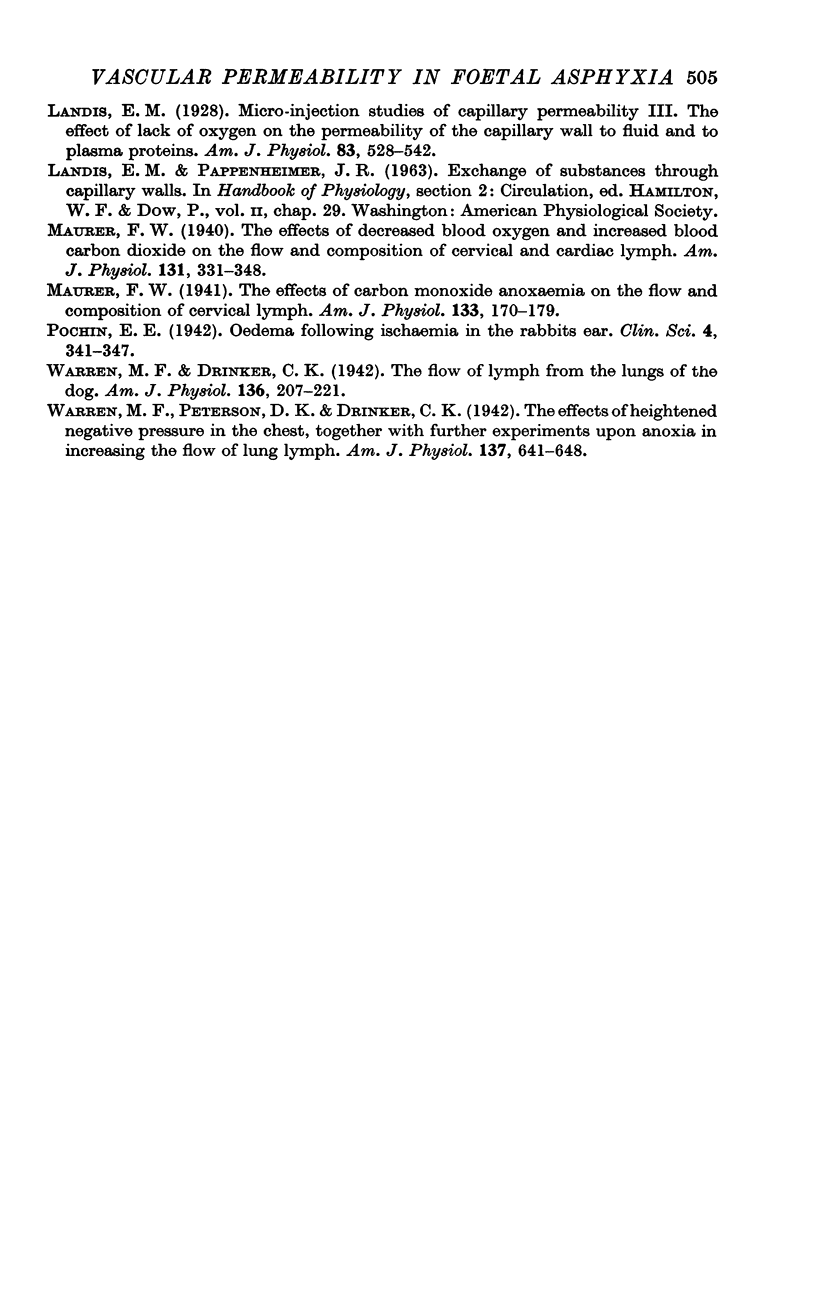Abstract
1. Experiments were performed on foetal lambs, exteriorized at Caesarean section, to determine the effects of asphyxia on the leakage of liquid from the circulation and on the permeability of lung capillaries to albumin. Following a period of control observation (30-120 min) the foetus was asphyxiated by occlusion of the umbilical cord for 5-10 min and then allowed to recover while observations were continued for a further 20-80 min.
2. Measurements were made of the lymph flow from the lungs, that had drained via the thoracic duct; of protein concentration in lymph and plasma; of arterial blood haematocrit, pH, PO2 and PCO2; and of arterial and left atrial pressures and heart rate. Human serum albumin labelled with 125I was infused intravenously during the control period and 125I count rates were followed in plasma and lymph throughout the experiment. Values for the transfer coefficient of albumin (Ė/V min-1, i.e. interstitial fluid clearance of albumin per unit of lung interstitial fluid volume) were determined during control, cord-occlusion and post-occlusion periods.
3. During cord occlusion arterial and left atrial pressure, haematocrit and plasma protein concentration all rose, returning to the control value by 20 min after release of cord occlusion. The haematocrit values indicated that about 9% of the blood volume was temporarily lost from the circulation. Lung lymph flow also increased, reaching a maximum in the 5 min period after release of occlusion and returning to the control level 15 min later. Values for Ė/V of albumin were at no time significantly different from those during the control period.
4. It was concluded that acute foetal asphyxia produced by umbilical cord occlusion caused an increased leakage of liquid from the circulation in general. This effect was temporary and was probably due to an increase in capillary pressure during cord occlusion. The asphyxia had no persistent effect on the permeability of lung capillaries to albumin.
Full text
PDF












Selected References
These references are in PubMed. This may not be the complete list of references from this article.
- Adamson T. M., Boyd R. D., Normand I. C., Reynolds E. O., Shaw J. L. Haemorrhagic pulmonary oedema ("massive pulmonary haemorrhage") in the newborn. Lancet. 1969 Mar 8;1(7593):494–495. doi: 10.1016/s0140-6736(69)91592-x. [DOI] [PubMed] [Google Scholar]
- Barcroft J., Kennedy J. A. The distribution of blood between the foetus and the placenta in sheep. J Physiol. 1939 Feb 14;95(1):173–186. doi: 10.1113/jphysiol.1939.sp003718. [DOI] [PMC free article] [PubMed] [Google Scholar]
- Body R. D., Hill J. R., Humphreys P. W., Normand I. C., Reynolds E. O., Strang L. B. Permeability of lung capillaries to macromolecules in foetal and new-born lambs and sheep. J Physiol. 1969 May;201(3):567–588. doi: 10.1113/jphysiol.1969.sp008773. [DOI] [PMC free article] [PubMed] [Google Scholar]
- COURTICE F. C., KORNER P. I. The effect of anoxia on pulmonary oedema produced by massive intravenous infusions. Aust J Exp Biol Med Sci. 1952 Dec;30(6):511–526. doi: 10.1038/icb.1952.49. [DOI] [PubMed] [Google Scholar]
- GAJL-PECZALSKA K. PLASMA PROTEIN COMPOSITION OF HYALINE MEMBRANE IN THE NEWBORN AS STUDIES BY IMMUNOFLUORESCENCE. Arch Dis Child. 1964 Jun;39:226–231. doi: 10.1136/adc.39.205.226. [DOI] [PMC free article] [PubMed] [Google Scholar]
- GITLIN D., CRAIG J. M. The nature of the hyaline membrane in asphyxia of the newborn. Pediatrics. 1956 Jan;17(1):64–71. [PubMed] [Google Scholar]
- HENDLEY E. D., SCHILLER A. A. Change in capillary permeability during hypoxemic perfusion of rat hindlegs. Am J Physiol. 1954 Nov;179(2):216–220. doi: 10.1152/ajplegacy.1954.179.2.216. [DOI] [PubMed] [Google Scholar]
- Howatt W. F., Humphreys P. W., Normand I. C., Strang L. B. Ventilation of liquid by the fetal lamb during asphyxia. J Appl Physiol. 1965 May;20(3):496–502. doi: 10.1152/jappl.1965.20.3.496. [DOI] [PubMed] [Google Scholar]
- Humphreys P. W., Normand I. C., Reynolds E. O., Strang L. B. Pulmonary lymph flow and the uptake of liquid from the lungs of the lamb at the start of breathing. J Physiol. 1967 Nov;193(1):1–29. doi: 10.1113/jphysiol.1967.sp008340. [DOI] [PMC free article] [PubMed] [Google Scholar]
- KORNER P. I., COURTICE F. C. The effects of acute anoxia and noradrenaline vasoconstriction on lymph flow and protein dynamics following transfusions of Ringer-Locke solution. Aust J Exp Biol Med Sci. 1954 Jun;32(3):321–332. doi: 10.1038/icb.1954.34. [DOI] [PubMed] [Google Scholar]


